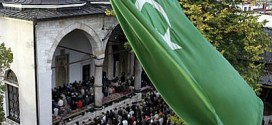The Emergence of the Concept of Ahl al-Sunnah wa al-Jama’ah
Assoc. Prof. Dr. Spahic Omer
Kulliyyah of Architecture and Environmental Design
International Islamic University Malay
 In the early days of Islam, there was no such thing as the concept of ahl al-sunnah wa al-jama’ah. The Prophet (pbuh) spoke much about the virtues of following the jama’ah (community), the Qur’an and his Sunnah, the last component signifying the way Islam is to be lived and practiced as taught and shown by the Prophet (pbuh), the most excellent role model for believers. At the same time, both the Qur’an and the Prophet’s Sunnah warned against disunity, schism and sects. The Qur’an says for example: “Surely they who divided their religion into parts and became sects, you have no concern with them; their affair is only with Allah, then He will inform them of what they did.” (al-An’am, 159).
In the early days of Islam, there was no such thing as the concept of ahl al-sunnah wa al-jama’ah. The Prophet (pbuh) spoke much about the virtues of following the jama’ah (community), the Qur’an and his Sunnah, the last component signifying the way Islam is to be lived and practiced as taught and shown by the Prophet (pbuh), the most excellent role model for believers. At the same time, both the Qur’an and the Prophet’s Sunnah warned against disunity, schism and sects. The Qur’an says for example: “Surely they who divided their religion into parts and became sects, you have no concern with them; their affair is only with Allah, then He will inform them of what they did.” (al-An’am, 159).
“Those who split up their religion, and become (mere) sects — each party rejoicing in that which is with itself.” (al-Rum, 32). It is not by a chance that this particular verse is preceded by verses wherein Allah speaks about the true religion, Islam, and some of its underlying qualities and traits, and how it had been patterned in accordance with the inner nature of man. Man’s inner disposition and Allah’s only religion, Islam, were meant for each other. This is to always serve as a powerful unifying factor among Muslims. It has so much potential that it can easily ward off all those forces which entail and advocate discordant and conflict-ridden inclinations. The Qur’an thus in the same context urges: “Then set your face upright for religion in the right state — the nature made by Allah in which He has made men; there is no altering of Allah’s creation; that is the right religion, but most people do not know.” (al-Rum, 30).
However, it has been made clear that making divisions and sects in Islam would in due course become inevitable. Such is to be viewed as a serious test for the followers of the final revelation to mankind and its Prophet, Muhammad (pbuh). It follows that those who fail the test will fall into grave error, but those who pass it will secure immense benefits. The Prophet (pbuh) once said that his Ummah (community) will split up into seventy-three sects or groups. All will enter Hellfire except only one which is the consensus of the community or the Ummah (jama’ah), or the one which will follow the course of the Prophet (pbuh) and his companions. In the same vein, during his farewell pilgrimage in his last sermon, the Prophet (pbuh) stressed that he was leaving behind him two things, the Quran and his example, the Sunnah, and if the people followed those two they will never go astray.
Since the dawn of Islamic culture and civilization, beginning with the Prophet’s era, Muslims coined different terms in order to describe those who followed the religious path trodden by the Prophet (pbuh) and his companions, and those who did otherwise. Some of the terms articulated for the purpose were: ahl al-qiblah (the people of the Qiblah, as a symbol of one vision, purpose and orientation), ahl al-sunnah (the people of the Prophet’s Sunnah), ahl ta’ah Allah (the people who duly obey Allah), ahl al-wafa’ bi ahd Allah (the people who fulfill their covenant with Allah), ahl al-tawhid (the people of Allah’s Oneness); ahl al-iman (the people of faith), ahl al-bid’ah (the people of religious innovations), ahl al-furqah (the people of separation and schism), ahl al-ahwa’ (the people who followed their vain desires). Of these idioms, most commonly utilized were ahl al-sunnah for true believers and the true followers of the Qur’an and Sunnah, and ahl al-bid’ah as well as ahl al-furqah for those who deviated from the clearly and straightforwardly delineated Islamic right path. In all probability, the first person who in academic circles used officially the expression ahl al-sunnah wa al-jama’ah was Imam Abu Ja’far al-Tahawi (d. 321 AH/ 933 CE) who in the introduction to his treatise on Islamic creed or aqidah (al-‘Aqidah al-Tahawiyyah) said that the book was an exposition of the creed of the ahl al-sunnah wa al-jama’ah in accordance with the understanding of Muslim jurists.
While commenting on the Qur’anic verse: “And as to those whose faces turn white (on the Day of Judgment), they shall be in Allah’s mercy; in it they shall abide.” (Al ‘Imran, 107), Abu al-Fida’ Ibn Kathir (d. 774 AH/ 1372 CE) remarked that a companion Abdullah b. Abbas (d. 68 AH/ 687 CE) said that the people implied in the said verse were (the people of) ahl al-sunnah wa al-jama’ah. However, it is very unlikely that the term or the maxim in question was known as such during the early days of Islam and that Abdullah b. Abbas, therefore, could make use of it in his lifetime. This is because there are no reports whatsoever that anybody ever employed it at the time of the Prophet’s companions or afterwards till perhaps the end of the 3rd AH/ 9th CE or the early 4th AH/ 10th CE centuries soon after which using the maxim ahl al-sunnah wa al-jama’ah became a standard. What Abu al-Fida’ Ibn Kathir did in his exegesis of the Qur’an, it appears, was that he in the spirit of his time and the latter’s lexis interpreted, rather than narrated verbatim, the words of Abdullah b. Abbas who in point of fact said (the people of) ahl al-sunnah and not (the people of) ahl al-sunnah wa al-jama’ah. This could be further corroborated by another eminent exegete, al-Qurtubi (d. 671 AH/ 1272 CE), who made reference to the same account of Abdullah b. Abbas in the context of elucidating the same Qur’anic verse, but maintained that Abdullah b. Abbas said that those people whose faces will turn white on the Day of Judgment will be (the people of) ahl al-sunnah rather than (the people of) ahl al-sunnah wa al-jama’ah.
Prior to the crystallization of the concept of ahl al-sunnah wa al-jama’ah, which entailed the quintessence of two most significant thrusts in Islam, that is, unity of the vision, purpose, struggle and goals of Muslims, and submission and conformity to the noblest divine standards and values, the Muslim community, as a part of God’s overall plan for his creations, including the followers of His religion, Islam, went through a rollercoaster of religious and socio-political ups and downs. Following an abrupt shift from perfect caliphate to hereditary monarchy – which henceforth was still called caliphate though — in year 41 AH/ 661 CE, which claimed the lives of some of the most illustrious personalities of early Islam and its nascent society, there appeared no end in sight for Muslim problems and dilemmas on all fronts. Some of the biggest upheavals always ensued whenever the institution of caliphate, regardless of how feeble, deficient and incompetent it and its personnel might have been, was overcome by some deviational teachings and tendencies as a result of which the same teachings and tendencies were then attempted to be championed and disseminated through the governmental institutional channels and means. Hence, Islamic society, for example, hit its lowest ebb when Abbasid caliph al-Ma’mun (d. 218 AH/ 833 CE) declared the Mu’tazili system of ideas (rational theology influenced by the rationalist methods of Hellenistic philosophy), which since their inception was at loggerheads with the mainstream of Islamic orthodox thought, an official creed not only of the government, but also of the whole state. What followed was one of darkest periods in Muslim history which lasted about 15 years, from approximately 218 to 234 AH / 833 to 848 CE, and involved three Abbasid caliphs, al-Ma’mun, al-Mu’tasim (d. 228 AH/ 842 CE) and al-Wathiq (d. 233 AH/ 847 CE). The period was characterized by mihnah or inquisition, which referred to Islamic courts established for a compulsory test of faith. For one to come closer to terms with the extent and depth of the political and ideological crisis which was then befalling Muslims, and which seems to have represented just the tip of the iceberg, one ought also to remember that the same caliph, i.e., al-Ma’mun, prior to the execution of his mentioned program, contemplated to adopt Shi’ism as his own ideology and to impose it on the government and society at large. Those unfortunate developments spawned as spinoffs loads of other to some extent lesser in scope and effect political and religious crises at both local and national levels.
Another extremely excruciating calamity that shook the Muslim community to its foundations was the appearance and rapid expansion of the Buyid Shi’ah dynasty which dominated mainly the territories of Iraq and Iran from 323 to 454 AH/ 934 to 1062 CE. The territories controlled by the Buyids used to function as the strongholds of the Abbasid caliphate, including the city of Baghdad, the Abbasid capital. That made the Abbasids very weak and completely subservient to the Buyids. The Buyids thus were able to make and unmake caliphs at will, and that is exactly what they used to do. Iraq was governed as a province from the Buyid capital, Shiraz, in Iran. The caliphate institution was passing through the period of its arguably deepest humiliation with Abbasid caliphs mere puppets in the hands of the schismatic “commanders of the commanders” (amir al-‘umara’), the official position which the Buyid rulers accorded themselves. They insisted that they be mentioned along with the caliph in the khutbah on Fridays. They even had their names stamped on the coinage. Moreover, having subscribed to Shi’ism, the Buyids established Shi’ah festivals, particularly the public mourning on the anniversary of the death of al-Husayn, Ali’s son and the Prophet’s grandson, and the rejoicing on the anniversary of the Prophet’s alleged appointment of Ali b. Abi Talib as his successor at Ghadir al-Kumm. The Buyids also built some Shi’ah funerary complexes. In this fashion, the perennial Shi’ah-Sunnah conflicts were brought to another level, and the religious and intellectual confusion that accompanied those conflicts were rendered even more profound and agonizing.
It was during those and other similar turbulent events that the concept of ahl al-sunnah wa al-jama’ah evolved and its usage was optimized. When the Saljuqs, the loyal supporters of the notion of ahl al-sunnah wa al-jama’ah arrived on the scene and defeated the Buyids, a new hope was given to everybody, to rulers and the public alike. The Saljuqs triumphantly entered Baghdad in 447 AH/ 1055 CE, thus “liberating” the caliphate institution from a Shi’ah nuisance. In order to bolster and sustain the victory of ahl al-sunnah wa al-jama’ah over ahl al-bid’ah wa al-furqah, no sooner had the Saljuqs crushed their foremost opponents, the Buyids, than they set out on a mission to institutionalize and thereby fortify orthodox Islam. This resulted, essentially, in the creation of scores of mosque multiplexes, schools, or madrasahs, and khanqahs where the study and dissemination of Sunni Islam was meant to be carried out in a hitherto unprecedented manner and mode. Those institutions were set up firstly in the early centers of the Saljuqi power, such as Nishapur, Isfahan and Baghdad. The trend soon extended throughout the territories which were controlled by the Saljuqs. It was to be followed quickly in Syria, Egypt and elsewhere, by the members of other independent or quasi-independent states and dynasties, such as the Ayyubids and Mamluks in Syria and Egypt.
It is of note that such was the ideological and political turmoil in society that immediately after their enthronement, the Saljuqs themselves needed sometime to adopt and defend a unified stand in relation to the question of ahl al-sunnah wa al-jama’ah and its various institutional considerations. There were in the Saljuqi midst those who favored Hanafism, as a Sunni school of jurisprudence (madhhab), and its relative rationalistic inclinations due to some of the Hanafis having been drawn to Mu’tazili theology. There were also those who subscribed and followed Shafi’i madhhab and Ash’ari theology. And of course, there were still some residues of Shi’ism and its populist and esoteric sentiments. The anti-rationalist Hanbali madhhab was well represented too. Several Abbasid caliphs were Hanbalis. One of them, caliph al-Qadir (d. 423 AH/ 1031 CE), who did not live long enough to experience the Saljuq rule, was so much concerned about restoring the ideological order firstly in capital Baghdad which was controlled by the Buyids and then if possible in the rest of the country, that he began a series of public condemnations of the Fatimids, their Isma’ili sympathizers, and all other parties and dynasties that did not support the Abbasids and their traditional beliefs. Embraced and amplified by Ash’ari theologians, those declarations were collected to form the famous al-risalah al-qadiriyyah (the Epistle of al-Qadir). The Qadiri Creed became the cornerstone of the new Abbasid orthodoxy and the official dogma of the caliphate. This traditionalist creed rejected Shi’ism and rationalism in all their forms but saved its severest condemnation for the Fatimids in Egypt and their Mu’tazili theologians. It was drawn heavily from Hanbali theology but benefitted from the dialectical reasoning of the Ash’arites. The Qadiri Creed was in effect long after the death of caliph al-Qadir. Abu al-Fida’ Ibn Kathir made a reference to it and its application and immense effect approximately thirty seven years after caliph al-Qadir’s passing away, in year 460 AH/ 1067 CE. Due to its critical objectives and purpose, the Qadiri Creed was for long regarded in many circles as the standard belief system of Islam and all Muslims. It was, according to Abu al-Fida’ Ibn Kathir, the official theological madhhab of ahl al-sunnah (the people of the Prophet’s Sunnah). Those who contravened it were deemed sinners and even disbelievers.
As an illustration of how severe and widespread the sectarian conflicts were in the nascent Saljuqi sultanate, it has been reported that in year 447 AH/ 1055 CE when the Saljuqs triumphantly entered Baghdad, the city witnessed violent clashes not only between the Sunnis and the Shi’ah, who in that particular year fought for long and so intensely that the government could not separate them, but also between the Ash’arites and the Hanbalis. The latter, having been backed by the Abbasid government, ultimately prevailed and became so dominant in the city of Baghdad that the Ash’arites were unable to attend neither Friday prayer nor the other five daily prayers in mosques.
 Dzemat Braunau
Dzemat Braunau


